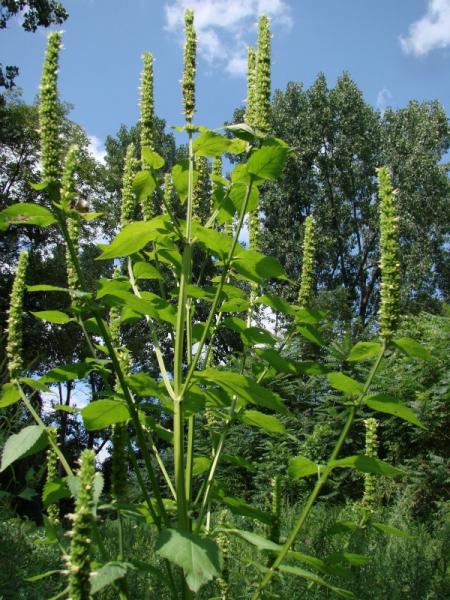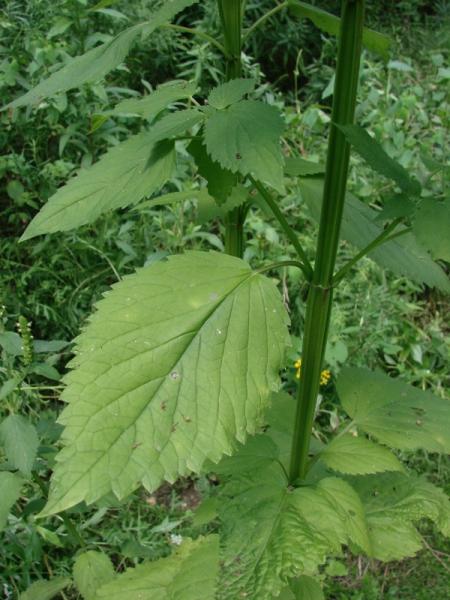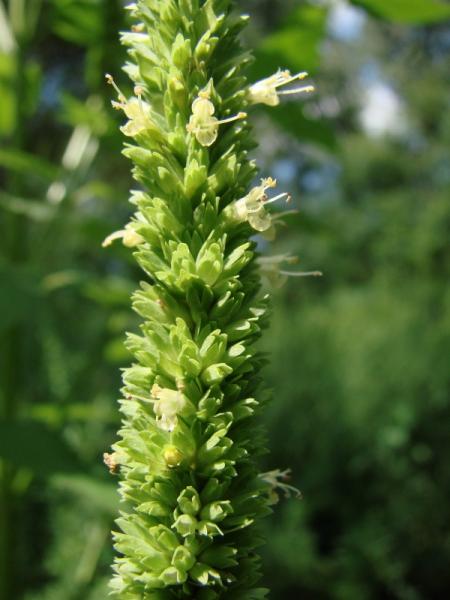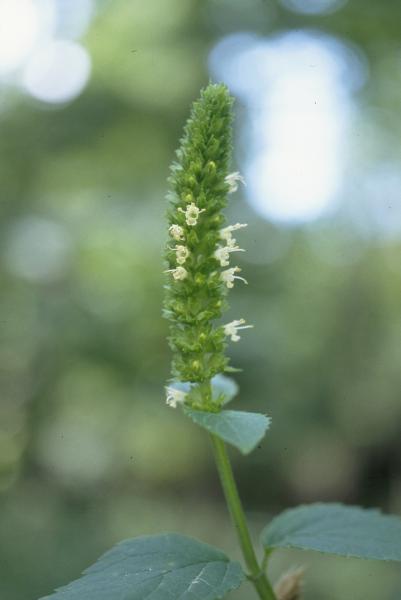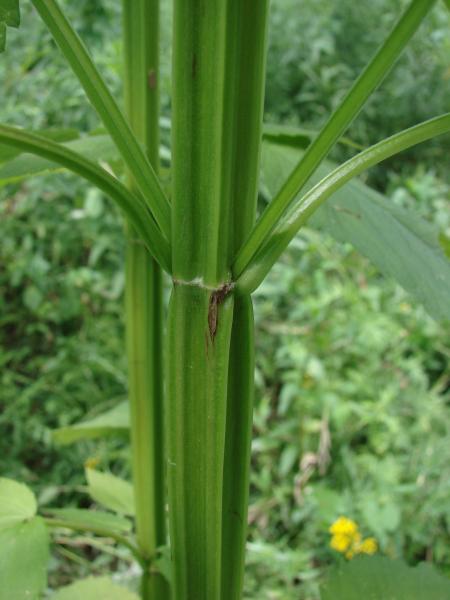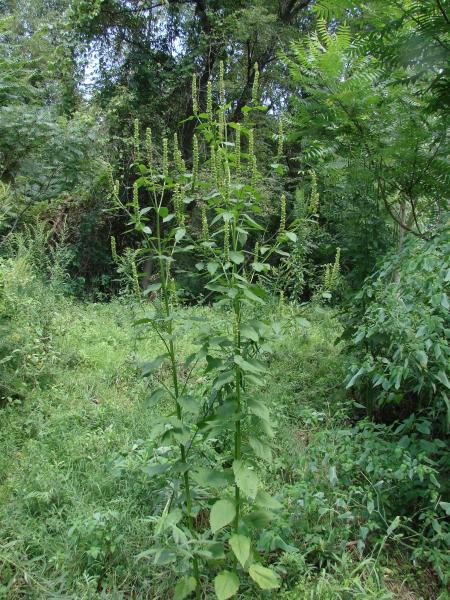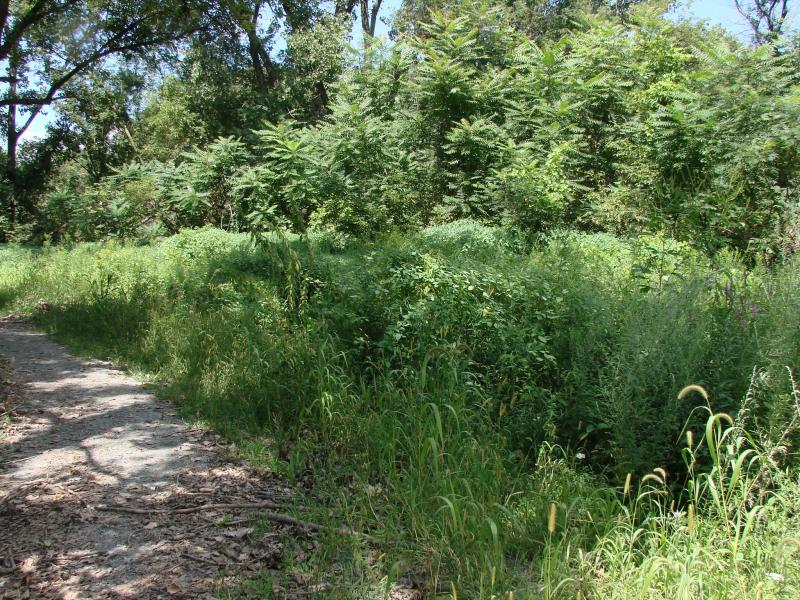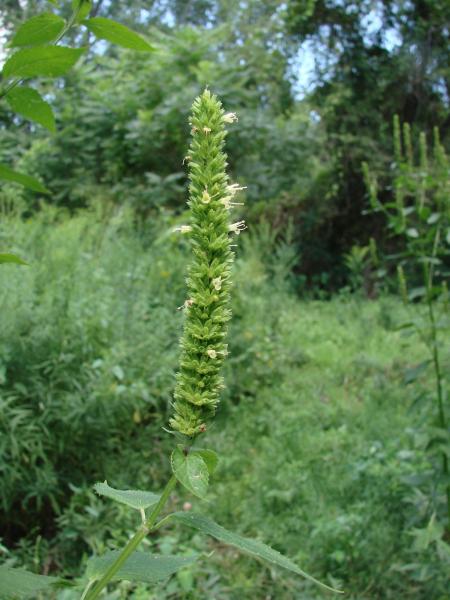Yellow Giant Hyssop
Agastache nepetoides (L.) Kuntze
- Class
- Dicotyledoneae (Dicots)
- Family
- Lamiaceae (Mint Family)
- State Protection
- Threatened
Listed as Threatened by New York State: likely to become Endangered in the foreseeable future. For animals, taking, importation, transportation, or possession is prohibited, except under license or permit. For plants, removal or damage without the consent of the landowner is prohibited.
- Federal Protection
- Not Listed
- State Conservation Status Rank
- S2S3
Imperiled or Vulnerable in New York - Very vulnerable, or vulnerable, to disappearing from New York, due to rarity or other factors; typically 6 to 80 populations or locations in New York, few individuals, restricted range, few remaining acres (or miles of stream), and/or recent and widespread declines. More information is needed to assign either S2 or S3.
- Global Conservation Status Rank
- G5
Secure globally - Common in the world; widespread and abundant (but may be rare in some parts of its range).
Summary
Did you know?
Even though this is not the true hyssop (Hyssopus officinalis) it does look similar to it but lacks the minty fragrance. The genus name is derived from its many flower spikes and the species name refers to its similarity to the catnip genus Nepeta (Fernald 1950). It is available in the horticulture trade and is used in perennial gardens, especially to attract bees and butterflies.
State Ranking Justification
There are 12 existing populations but most of them are of poor quality in areas threatened by invasive species or human disturbance. There are about 10 historical occurrences which need further survey work.
Short-term Trends
The present populations seem to be declining because of competition by invasive species and human disturbance.
Long-term Trends
There were many historical records from Long Island and western New York which have not been found or are considered extirpated. Habitat development and invasive species in naturally disturbed areas have probably reduced the species over the last 100 years.
Conservation and Management
Threats
Succession is the most serious threat to this species, especially in naturally disturbed areas and by invasive species. Habitat destruction and destruction of plants by herbicides and improper mowing are also threats which have reduced occurrences around metropolitan areas.
Conservation Strategies and Management Practices
The preferred habitat management techniques are not known for this species. Is not known why it prefers certain disturbed areas over others. However, preventing succession by woody plants and controlling invasive species should help preserve the population.
Research Needs
The habitat preference of the species needs to be studied because it occurs in a wide variety of disturbed habitats and we do not know the exact environmental factors it prefers.
Habitat
Habitat
In New York this species has been found in a diversity of habitats, including weedy or early-successional areas such as roadsides, railroads, and thickets. Many of the known sites for Yellow Giant-hyssop are on limestone-derived soils, and support plant species associated with rich sites. The list of associated plants at these sites includes many calciphiles as well as common weeds of rich woods (New York Natural Heritage Program 2007). Upland in more or less open deciduous woods (oak, beech-maple); also meadows, fencerows, thickets, and lowland woods (Voss 1996). Open woods (Gleason and Cronquist 1991). Rich thickets and borders of woods (Fernald 1970).
Associated Ecological Communities
- Beech-maple mesic forest
(guide)
A hardwood forest with sugar maple and American beech codominant. This is a broadly defined community type with several variants. These forests occur on moist, well-drained, usually acid soils. Common associates are yellow birch, white ash, hop hornbeam, and red maple.
- Calcareous red cedar barrens*
(guide)
A small-patch calcareous rocky summit community occurring on dry, south-facing to southwest-facing slopes and low summits. These sites are characterized by stunted, sparse woodlands with small grassland openings.
- Calcareous talus slope woodland*
(guide)
An open or closed canopy community that occurs on talus slopes composed of calcareous bedrock such as limestone or dolomite. The soils are usually moist and loamy; there may be numerous rock outcrops.
- Limestone woodland*
(guide)
A woodland that occurs on shallow soils over limestone bedrock in non-alvar settings, and usually includes numerous rock outcrops. There are usually several codominant trees, although one species may become dominant in any one stand.
- Maple-basswood rich mesic forest
(guide)
A species rich hardwood forest that typically occurs on well-drained, moist soils of circumneutral pH. Rich herbs are predominant in the ground layer and are usually correlated with calcareous bedrock, although bedrock does not have to be exposed. The dominant trees are sugar maple, basswood, and white ash.
* probable association but not confirmed.
Associated Species
- Acer nigrum (black maple)
- Acer saccharum (sugar maple)
- Ailanthus altissima (tree-of-heaven)
- Artemisia vulgaris (mugwort)
- Celtis occidentalis (northern hackberry)
- Euonymus obovata
- Lindera benzoin (spicebush)
- Liriodendron tulipifera (tulip tree, tulip poplar, yellow poplar)
- Lonicera spp.
- ostrya virginiana
- Staphylea trifolia (bladdernut)
- Tilia americana
- Ulmus thomasii (rock elm)
Range
New York State Distribution
This herb species has been found throughout much of southern, western, and central New York on sites with rich soil. A particularly high number of collections have been reported within close proximity to New York City, Buffalo/Niagara Falls, or Ithaca.
Global Distribution
This species ranges from southern Quebec and Vermont west as far as southern Ontario and South Dakota, and south from Georgia and Alabama to Oklahoma.
Identification Comments
General Description
Yellow Giant-hyssop is a tall (up to 2 meters) herb with a smooth, square stem with winged angles and coarsely toothed, ovate leaves. The leaves are pubescent underneath. The pale, greenish yellow flowers occur in cylindrical spikes up to eight inches long at the end of the stem. These spikes, dense with flowers, are held upright like ears of corn; the genus name is derived from "stachys", meaning an ear or corn or wheat. The individual flowers are about .75 cm long, and have five-lobes, with the stamens protruding past the ends of the petals.
Best Life Stage for Proper Identification
This plant is best sought when in flower, though it may also be identified from stems with mature or senescing fruits.
Similar Species
The closest relative and most similar-looking species to Agastache nepetoides is Agastache scrophulariifolia. Agastache scrophulariifolia has purple flower petals and a less strongly 4-sided stem, There may be introduced and horticultural escapes within this genus that resemble our native species.
Best Time to See
Yellow Giant-hyssop flowers from late July to early September and the fruits may persist through the first few frosts and even be visible into the next spring if the winter is not severe.
- Vegetative
- Flowering
- Fruiting
The time of year you would expect to find Yellow Giant Hyssop vegetative, flowering, and fruiting in New York.
Yellow Giant Hyssop Images
Taxonomy
Yellow Giant Hyssop
Agastache nepetoides (L.) Kuntze
- Kingdom Plantae
- Phylum Anthophyta
- Class Dicotyledoneae
(Dicots)
- Order Lamiales
- Family Lamiaceae (Mint Family)
- Order Lamiales
- Class Dicotyledoneae
(Dicots)
- Phylum Anthophyta
Additional Common Names
- Yellow Giant-hyssop
Additional Resources
Best Identification Reference
Gleason, Henry A. and A. Cronquist. 1991. Manual of Vascular Plants of Northeastern United States and Adjacent Canada. The New York Botanical Garden, Bronx, New York. 910 pp.
Other References
Clemants, Steven and Carol Gracie. 2006. Wildflowers in the Field and Forest. A Field Guide to the Northeastern United States. Oxford University Press, New York, NY. 445 pp.
Fernald, M. L. 1950. Gray's manual of botany. 8th edition. Corrected printing (1970). D. Van Nostrand Company, New York. 1632 pp.
Holmgren, Noel. 1998. The Illustrated Companion to Gleason and Cronquist's Manual. Illustrations of the Vascular Plants of Northeastern United States and Adjacent Canada. The New York Botanical Garden, Bronx, New York.
New York Natural Heritage Program. 2010. Biotics database. New York Natural Heritage Program. New York State Department of Environmental Conservation. Albany, NY.
New York Natural Heritage Program. 2024. New York Natural Heritage Program Databases. Albany, NY.
Newcomb, Lawrence. 1977. Newcomb's Wildflower Guide: An Ingenious New Key System for Quick, Positive Field Identification of the Wildflowers, Flowering Shrubs, and Vines of Northeastern and North-Central North America. Little, Brown and Company. Boston.
Rhoads, Ann F. and Timothy A. Block. 2000. The Plants of Pennsylvania, an Illustrated Manual. University of Pennsylvania Press, Philadelphia, PA.
Weldy, T. and D. Werier. 2010. New York flora atlas. [S.M. Landry, K.N. Campbell, and L.D. Mabe (original application development), Florida Center for Community Design and Research http://www.fccdr.usf.edu/. University of South Florida http://www.usf.edu/]. New York Flora Association http://newyork.plantatlas.usf.edu/, Albany, New York
Links
About This Guide
Information for this guide was last updated on: January 18, 2008
Please cite this page as:
New York Natural Heritage Program. 2024.
Online Conservation Guide for
Agastache nepetoides.
Available from: https://guides.nynhp.org/yellow-giant-hyssop/.
Accessed July 26, 2024.
